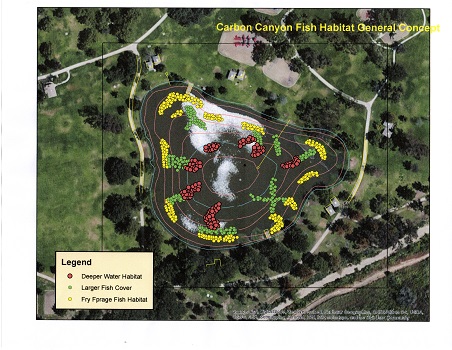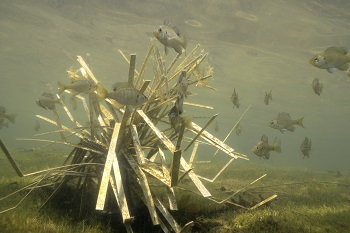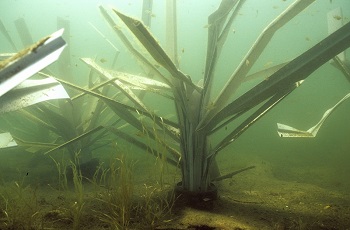Artificial fish habitat improving parks in Orange County California
Posted by David Ewald on 20th Oct 2014
Some California bass and panfish have new homes on their way to Carbon Canyon Regional park in Brea California, which has been recently dredged, sealed and getting ready for fishing. A number of flooding events had carried extensive amounts of sediment into the lake and filled it almost completely in. The lake has been reclaimed and water has been placed back in, awaiting arrival of the six different models of artificial fish habitat from Fishiding.com of northern Illinois.
The habitat manufacturer provides a fully patented line of artificial fish structures the consumer bends to shape, then tosses in lake or pond. Almost like an artificial christmas tree opens into shape out of the box, these units come in over 26 different varieties from 18" tall to over 15' in height. The self weighted fish attractors stand upright after being tossed in the water, due to the weighted "stump like" base. Bass gravitate to this natural feeling stump, fanning and creating beds to spawn next to them as they draw and hold warmth in the cooler spring temperatures.
Aquatechnex,LLC of Bellingham,Wa, services all of the Orange County lakes, incliding carbon Canyon. They were called in with requests to create a top knotch public fishing lake. Owner, Terry McNabb who also sits as president of the North American Lake Management Society, has the experience and staff to handle projects of all sizes, speciallizing in large scale waterways. Weed control, water quality testing, lake mapping, stocking and overall water health are the speciaties of this well established firm. Creating a one of a kind park setting fishing lake with heavy fishing pressure, Orange County residents will have no excuse to not catch fish. Fishing piers, open spaces and strategically placed habitat designed and installed for fishing access, will ensure abundant smiling faces from all anglers.

The key to a successful, abundant fishery is food and lots of it. Shallower areas of the lake will be set up as small fish and fry shelter. These structures will create areas where where a food web establishes and protects the vulnerable fry. From these areas, migration safety corridors to deeper open water will be set to allow forage fish some safety from predation, while concentrating predator species. A bass needs to eat 10 pounds of small fish to gain one pound in weight so growing the food is essencial to growing trophy gamefish.
Shallow models with dense protection provide hiding places for fry and forage fish, minnows and zooplankton. Over 600 shallow units in three different models will make up the 1'-4' littoral zone, where plants normally take root. We look at this area as the "grocery store", which needs the shelves stocked with food varieties before opening the doors for customers. Periphyton, the "fuzz" that grows on objects underwater not only provides the food needed for fish to graze on, but also works naturally to convert excessive nutrients into this "mother's milk" that all young of the year fish need in their first year of life.
Engbretson underwater photography
A mixture of forage fish including sunfish and shad will be added first and allowed to establish themselves after placement of the new habitat structures. Bass will be added later, after the forage fish have had an oppourtunity to establish and begin to reproduce.
Mid depth structure provides the "teenagers" room to swim through, feed and still find protection from the biggest predators in the system. Like our growing teens, these fish are constantly eating and on the go, but have much to learn about life's dangers. The goal is to allow this size fish to have safety from bigger fish eating them before they gain more weight, providing Mr. Bass a good sized meal. Three hundred, 42"x84" Safehouse units will connect the important shallow breeding areas to the mid and deep water areas of the lake, each containing over 55 sq.' of shade and surface area. Dozens of 1"-4" pvc limbs branch out into abstract angles, creating "bushes", which as in nature, no two are alike.
Engbretson underwater photography
The 6.5 Carbon Canyon acre lake will also have over 100 large, deep water structures to provide shelter and resting areas for large gamefish species. These coarse, tall and substantial units provide massive shade, tight spaces and variations of textures, normally found in nature that fish prefer.
Delivery is scheduled for the end of October, with installation soon thereafter.





